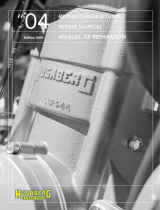
TABLE OF CONTENTS 2
TABLE OFCONTENTS
MEANS OF REPRESENTATION ............................................ 4
IMPORTANT INFORMATION ................................................ 5
VIEW OF VEHICLE............................................................... 7
View of the vehicle from the left front (example)................. 7
View of the vehicle from the right rear (example) ................ 8
SERIAL NUMBERS.............................................................. 9
Chassis number............................................................... 9
Engine number................................................................ 9
Shock absorber part number............................................. 9
CONTROLS....................................................................... 10
Throttle grip.................................................................. 10
Hand brake lever ........................................................... 10
Kill switch .................................................................... 10
Opening filler cap.......................................................... 10
Closing filler cap ........................................................... 10
Opening oil tank cap (50 SX Mini) .................................. 11
Closing oil tank cap (50 SX Mini).................................... 11
Fuel tap........................................................................ 11
Choke (50 SX)............................................................... 11
Choke (50 SX Mini) ....................................................... 11
Kickstarter.................................................................... 12
Foot brake lever............................................................. 12
Plug-in stand ................................................................ 12
PUTTING INTO OPERATION............................................... 13
Advice on first use......................................................... 13
Running in the engine.................................................... 14
RIDING INSTRUCTIONS .................................................... 15
Checks and maintenance measures when preparing for
use .............................................................................. 15
Starting ........................................................................ 15
Starting up ................................................................... 16
Riding .......................................................................... 16
Braking ........................................................................ 16
Stopping, parking .......................................................... 16
Refueling...................................................................... 17
Filling up with oil (50 SX Mini)....................................... 17
SERVICE SCHEDULE......................................................... 18
Service schedule ........................................................... 18
TUNING THE CHASSIS...................................................... 20
Adjusting the rebound damping of the shock absorber....... 20
Measuring rear wheel sag unloaded ................................. 20
Checking the static sag of the shock absorber .................. 20
Checking the riding sag of the shock absorber .................. 21
Adjusting the spring preload of the shock absorber x ...... 21
Adjusting the riding sag x............................................. 22
Vehicle level ................................................................. 22
Adjusting the fork overhang x ....................................... 22
Adjusting seat height x ................................................ 23
Handlebar position ........................................................ 23
Adjusting handlebar position x...................................... 24
MAINTENANCE WORK ON THE CHASSIS ........................... 25
Raising the motorcycle with a lift stand ........................... 25
Removing the motorcycle from the lift stand .................... 25
Cleaning dust boots of fork legs ...................................... 25
Removing the fork legs x.............................................. 26
Installing the fork legs x............................................... 26
Checking play of steering head bearing............................ 27
Adjusting the play of the steering head bearing x............ 27
Greasing the steering head bearing x............................. 28
Removing the lower triple clamp x ................................ 28
Installing the lower triple clamp x................................. 29
Removing the shock absorber x..................................... 31
Installing shock absorber x........................................... 31
Dismounting the start number plate ................................ 32
Installing the start number plate ..................................... 32
Dismounting the front fender.......................................... 32
Installing the front fender............................................... 32
Removing the seat......................................................... 33
Mounting the seat ......................................................... 33
Removing the air filter x............................................... 33
Installing the air filter x ............................................... 34
Cleaning the air filter and air filter box x........................ 34
Removing main silencer ................................................. 34
Installing the main silencer ............................................ 35
Changing the glass fiber yarn filling of the main
silencer x ................................................................... 35
Removing the chain guard (50 SX).................................. 36
Installing the chain guard (50 SX)................................... 36
Removing the engine sprocket cover x........................... 36
Installing the engine sprocket cover x............................ 37
Checking the chain for dirt ............................................. 37
Cleaning the chain......................................................... 37
Checking the chain tension ............................................ 38
Checking the chain, rear sprocket, engine sprocket and
chain guide................................................................... 38
Adjusting chain tension.................................................. 40
Adjusting the chain guide x.......................................... 40
BRAKES........................................................................... 41
Checking the play of the hand brake lever........................ 41
Adjusting the play of the hand brake lever........................ 41
Adjusting the basic position of the hand brake lever.......... 41
Checking brake discs ..................................................... 41
Checking front brake fluid level....................................... 42
Adding front brake fluid x ............................................ 42
Checking the front brake linings...................................... 43
Removing front brake linings x ..................................... 43
Installing the front brake linings x................................. 44
Changing the front brake linings x................................. 44
Checking the free travel of the foot brake lever ................. 45
Adjusting the free travel of the foot brake lever x............ 45
Adjusting the basic position of the foot brake lever x ...... 46
Checking rear brake fluid level........................................ 46
Adding rear brake fluid x.............................................. 47
Checking the rear brake linings ....................................... 48
Removing rear brake linings x....................................... 48
Installing the rear brake linings x.................................. 48
Changing the rear brake linings x.................................. 49
WHEELS........................................................................... 51
Removing front wheel x................................................ 51
Installing the front wheel x........................................... 51
Removing rear wheel x................................................. 51
Installing the rear wheel x............................................ 52
Checking the tire condition............................................. 52
Checking tire air pressure............................................... 53
Checking spoke tension.................................................. 53
COOLING SYSTEM ............................................................ 54
Cooling system .............................................................. 54
Checking the antifreeze and coolant level ........................ 54
Checking the coolant level.............................................. 55
Draining the coolant x.................................................. 55
Refilling coolant x ....................................................... 56



























